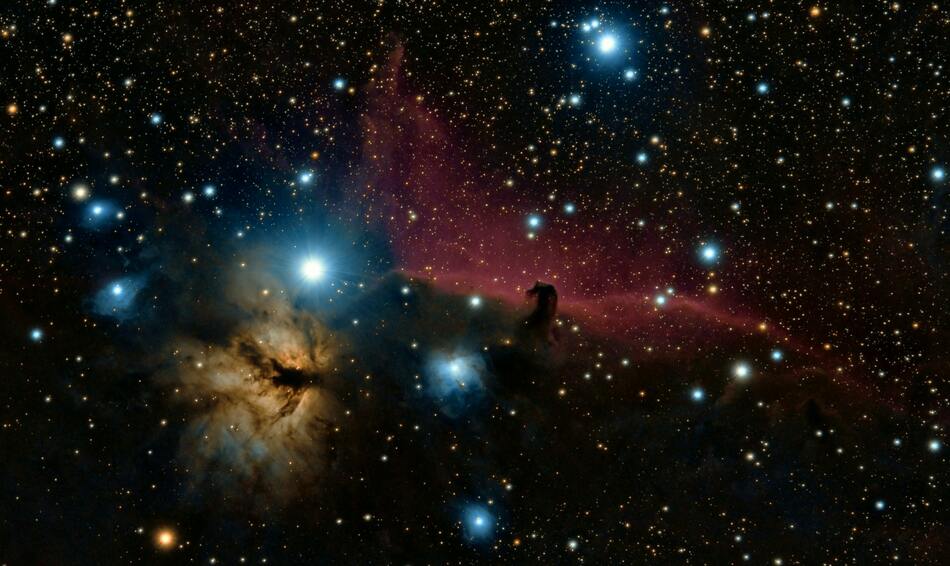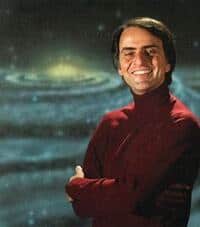
Ancient Vedic texts teach us that five fundamental elements emanate from the vibration of Om. Together they comprise all aspects of reality that we experience. These five elements are Earth (Prithvi), Air (Vāju), Fire (Agni), Water (Jala), and Space (Ākāsa). Each is associated with a planet – Mercury for Earth, Saturn for Air, Mars for Fire, Venus for Water, and Jupiter for Space. As we shall see, Space actually is the first element. However, when the elements are discussed, it tends to wind up last in line, probably because it is the one that is the least understood.
With the exception of Space, each of the elements is associated with three zodiac signs.
| EARTH | Taurus | Virgo | Capricorn |
| AIR | Gemini | Libra | Aquarius |
| FIRE | Aries | Leo | Sagittarius |
| WATER | Cancer | Scorpio | Pisces |
Space is the mother of the other elements. It is present in all signs and represents Vishnu, preserver and guardian of the universe. Although invisible to the naked eye, Vishnu is everywhere. Higher spiritual enlightenment is founded on the experience of Ākāsa element as luminous nothingness.
Despite its paramount importance, the Space element remains elusive in Astrology. It is the least talked about and referenced of all of the elements. For example, it is common to hear about the influence of the fire element on Aires, but it is rare to find mention of the Space element influence on this sign. What is it about Space that makes it so difficult to pin down? Keep reading as I explore the elusiveness of the Space element in Astrology.
The Five Elements in Popular Culture

There are many examples of the five elements appearing in popular media and culture. For example, musical groups such as Mastodon, Ghost, and Earth, Wind, and Fire all used them in their logos or titles of albums. Numerous video games also have these five elements in their themes and backstories. The film industry also has made reference to the elements on several occasions. One example is a blockbuster film released in 1997 by writer and director Luc Besson entitled The Fifth Element. It starred Bruce Willis, Gary Oldman, and Mila Jovovitch.

Set in the 23rd century, the central theme of the movie is the impending destruction of planet Earth by a malevolent cosmic entity that appears every 5000 years. The only way to stop this evil is to recover four stones that represent the four classical elements: Earth, Air, Fire, and Water, along with an elusive fifth element that remains a mystery until the last minute and saves Earth from doom.
Of course, the four classical elements are not fantasy. They appear throughout ancient history in a number of cultures. Many scholars believe that they originated in the Vedic texts in India, specifically the Upanishads. They represent a way of knowing and understanding our material world. Everything that we see, hear, taste, smell, and touch can be categorized as being one or a combination of these elements.
In Luc Besson’s movie, the elusive fifth element is a woman, portrayed by Milla Jovovich. Once the four stones representing the other four elements are recovered and deployed at a secret Egyptian temple, they combine to work through her to emit a powerful beam of light that destroys the malevolent cosmic entity and saves the Earth.
In real life, the fifth element also is elusive and mysterious. But it is not a woman that miraculously saves our planet. It is not material in the classic sense of the word. In fact, we cannot use the other four elements to classify it. The elusive fifth element is Space.
Science Rejects the Five Elements
The five-element system was used extensively throughout history to describe our material reality. It was only in the 20th and 21 centuries CE that it fell into disuse and was replaced by the Periodic Table of Elements. Whereas the five elements were used as metaphors to describe the material world, the Periodic Table identified physical matter at its fundamental atomic level. The first comprehensive table was developed by Russian chemist Dimitri Mendeleev in 1869. He arranged known chemical elements based on their atomic mass.
The current Periodic Table consists of 118 elements that are arranged by atomic number, 94 of which occur naturally on planet Earth. The remaining 24, which conceivably could occur naturally somewhere else in the universe, have been created artificially in laboratories.

As time marched on, science and technology occupied more and more of peoples’ lives. The notion that Space could be an element seemed preposterous and a product of immature thought. After all, Space had no physical qualities. There was no place for it on the Periodic Table of Elements!
The other four ancient elements all had definable characteristics that were explainable by science. For example, water consists of two atoms of Hydrogen and one atom of Oxygen, numbers 1 and 8 on the Periodic Table of Elements. Fire is a chemical reaction. Space, on the other hand, was emptiness, a void without a definable shape or form.
Does this mean that the Space element doesn’t exist, at least as we understand existence? If not, then what did the Ancients mean when they called it one of the fundamental elements of nature, on equal standing with Earth, Air, Fire, and Water? How could Space be the mother of all elements if it doesn’t exist?
The Discovery of Dark Matter and Dark Energy

Dark matter is needed to hold galaxies together. Your mind is a Galaxy. More dark than light. But the light makes it worthwhile.
Matt Haig
It turns out that what scientists thought they knew about the universe even 50 years ago seems naïve today. We now know that space is full of something called dark matter and dark energy. In fact, dark matter is projected to account for about 85% of the matter in the universe. However, we only know of its existence by inference. The nature of dark matter remains elusive. Scientists are certain that it exists because there are gravitational phenomena that only can be explained if more matter is present in the universe than can be observed. For example, calculations demonstrate that many galaxies would fly apart, would not have formed at all, or would move differently if they did not contain a large amount of unseen matter.

It’s everywhere, really. It’s between the galaxies. It is in this room. We believe that everywhere that you have space, empty space, that you cannot avoid having some of this dark energy.
Adam Riess
A similar quandary exists for dark energy. Based upon the Big Bang Theory, scientists predicted that the universe would expand at a constant rate until energy released by the initial explosion dissipated and expansion would slow. However, observed data indicated that the expansion of the universe actually is accelerating!
How could it be accelerating when it’s supposed to be slowing down?
In the absence of a new, yet to be defined, form of energy (dark energy), it was impossible to explain how an accelerating universe could exist and be measured.
Current estimates are that dark matter and dark energy constitute 95% of the total mass-energy content of the universe. This means that our universe contains only 5% ordinary mass and energy. This is mind-boggling when you stop and think about it. Our vast universe consists of a mere 5% of things that we can either see or detect with scientific instruments; 95% remains a mystery.

This tells us that the Space element is not an empty void. It is bursting with potential. Vedic texts tell us that everything emerges from Space. It is a pregnant womb from which new galaxies, new solar systems, and new life are born. This begs the question. How could the Ancients have known this when science only has recognized it in the past 30 years?
We are made of star stuff.
Carl Sagan
With what we know now, Dr. Sagan’s quote should be revised to read: We are made of Space (dark matter and dark energy) and star stuff.
At the molecular level, we also see something similar. Even the most solid things in nature, such as diamonds and tree trunks actually consist mostly of space. They are like mini universes, with atoms instead of galaxies and Suns embedded in a matrix of Space, most likely also consisting of dark matter and dark energy. It is the particular alignment of atoms in this spatial matrix that makes diamonds and tree trunks appear solid to us. The same holds true for man-made materials like steel and concrete.

Science estimates that the human body consists of 60% water. This is referenced in an episode of Star Trek: The Next Generation entitled Home Soil. In it, a microscopic crystal alien race assumes control of the ship’s computer and refers to the human crew as “ugly bags of mostly water.”
But wait a minute.
We learned previously that water consists of 2 atoms of Hydrogen and 1 atom of Oxygen, and that these atoms are embedded in a matrix of Space. This means that our bodies also are mostly Space. Are humans and other organisms literally bursting with dark matter and dark energy, like the universe? If yes, then the inescapable conclusion is that each of us is full of the potential inherent in the universe. This is precisely what Vedic texts informed us 5000-7000 years ago!
On a personal level, the element of Space makes room for us to live our lives. An empty stomach receives nourishing food that keeps our bodies healthy and functioning. An empty chair provides space for a person to sit, offering us an opportunity to make a new acquaintance. Space is the primordial matrix from which new potentials arise.
Space Is the Genesis of Learning and Growing

If you memorize the periodic table it will speed you up if you’re a chemist, but by and large, the reason you have a periodic table is so that you can store that information outside of your body. That way it frees up some part of your brain to do something else.
Bill Nye
In the New Testament of the Christian Bible, Jesus regularly makes the following proclamation to crowds to which he is speaking.
Those who have ears, let them hear.
As a young girl, I always found this statement puzzling. I suspected that it merely was a gimmick designed to capture attention. Everyone I had met in my young life had ears and none was deaf. Of course, they could hear!
Why bother saying something so obvious?
Some scholars have taken this statement to mean that Jesus was speaking to every man and woman, not just the pious elite. He wanted to make that clear from the beginning. While this is a reasonable interpretation, particularly given the historical context, I believe that his words have a more profound meaning that connects directly to the element of Space in Astrology.
To explore this, let’s consider the story of the Zen Master and His Pot of Tea.

A young scholar visited a Zen Master, hoping that he would impart some kernels of wisdom to him. After greeting the scholar, the master offered him tea. The scholar accepted and the master poured tea into the young man’s cup. Soon, the tea overflowed the cup, fell onto the table, where the liquid followed a winding path, forming a waterfall that cascaded over the table’s edge onto the floor.
Seemingly ambivalent to the accident, the master kept pouring. Exasperated, the young scholar shouted: “Stop! Can’t you see that my cup is full?”
The Zen Master replied: “Of course, I can, and until your mind is empty you will not hear what I have to say.”
Returning to Jesus, he was saying the same thing as the Zen Master. If I add the unsaid words of his message it is clear. “Those who have ears [that are not blocked by past experience, assumptions, and prejudices], let them hear.”
In other words, we must empty our minds so that there is Space for wisdom to enter.

If our minds are filled with memories or preconceived notions, particularly if they relate to past physical or psychological trauma, the mind is overwhelmed and eventually breaks down. In order to move forward and develop a new self, there must be space for the new creation to be born.
The real purpose of meditation is to help us to realize on ever-deeper levels of our being who we really are, in our deepest nature.
Swami Kriyananda
For millennia, Shamans have used rituals, often coupled with taking various hallucinogenic natural substances, to open space in their minds so that they could communicate with ancestors or deities and receive wisdom from them.
Meditation, chanting mantras, and prayer are other safer routes to manifesting this space. Through meditation, we can quiet the mind and connect with our deepest nature. It is a way to bring the element of Space to the forefront and to experience the creative potential that it freely offers to us.
Acknowledgements
I am indebted to the lectures and teachings of Kavindra Rishi, which have helped to form the organization of this article and elucidate its concepts.
Recent Content
The following is the story of the origin of Rahu, known in Western Astrology as the North Node of the Moon. Keep reading. There are several lessons to be learned in this...
A common form of forecasting in the modern world is that used by Meteorology. This science uses measurements, such as temperature, atmospheric pressure, humidity, and the behavior of the winds...
